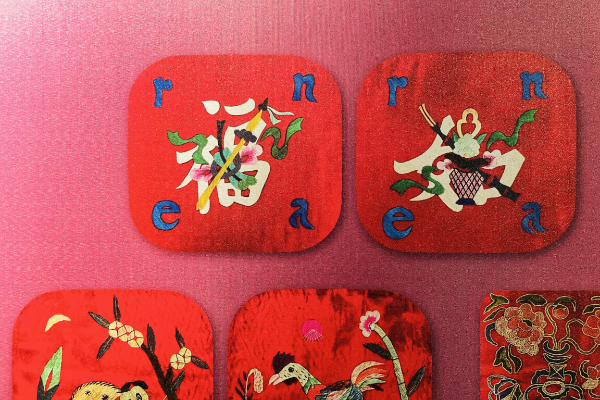It is probably not surprising that Chinese embroidery art covers a wide range of topics given its long history. In an exhibition newly opened at the Nanyue King Museum, visitors can catch a glimpse of the history of China from the late Qing dynasty to the 20th century, through the patterns stitched onto pillows.

Two box-shaped pillows on exhibition at the Nanyue King Museum
Titled "The Flowery Patterns in Pillow Embroidery," the exhibition showcases more than 200 pieces of 'Zhending' (枕頂), which literally means the two end sides of a pillow. Before the introduction of Western-style flat pillows, pillows in China were box-shaped and made from ceramics or cloths stuffed with buckwheat hulls and cassia seeds, among other materials. To close a cloth pillow, two embroidery patches would be stitched onto the two sides of the pillow.
Zhending, along with cotton pillows, reached the height of popularity in the Ming and Qing dynasties as improvements in cotton textile technology lowered the price of cotton, according to Hu Zaiqiang, the Deputy Director of the Exhibition Department of the Nanyue King Museum. Starting from the Republic of China period, they were gradually replaced by Western-style flat pillows.
Butterflies, flowers, and children at play are commonly seen auspicious images on Zhending, through which Chinese people expressed their wishes for harmony, love, and happiness. Additionally, people would also incorporate words such as poetry lines and intellectual quotes to help improve their moral and spiritual character. Many of these patterns reflect the culture of a certain historical period.

A piece of Zhending from the Qing Dynasty, which shows the teaching that a real gentleman should be persistent and indifferent to fame and wealth

Zhending patterns from the late Qing dynasty or the Republic of China period, which feature Latin-script letters, indicate the Western influence on the domestic life of Chinese in this period

A western-style pillow cover from the period of the Republic of China

A pillow cover from the 1950s-1960s, which says "love our homeland"
If you want to visit:
Venue: the 3rd floor of the Site of King’s Tomb, Nanyue King Museum
Opening Hours: 9 am-5:30 pm, Tuesday to Sunday, July 10 to August 11, 2024
Tickets: 10 RMB for general admission, 5 RMB for students and seniors between 60-65, free for seniors over 65 and minors under 18.
Where to get the tickets: WeChat account “南越王博物館”-“王墓展區(qū)”-“門(mén)票預(yù)約”
All materials marked with "source: English.gz.gov.cn" on this website (including but not limited to text, photographs, audio and video materials) are the copyrighted property of Guangzhou International (the official website of Guangzhou Municipality). Without prior authorization from Guangzhou International, any media, website, organization or individual shall not transmit, interlink, distribute or republish such materials in any form. Any media and website authorized to republish such materials shall mark them with "source: Guangzhou International (English.gz.gov.cn)". Infringement of these copyrights will result in legal action.
